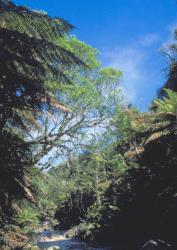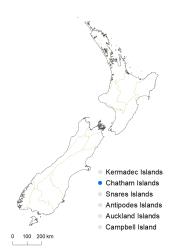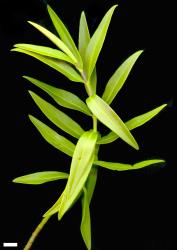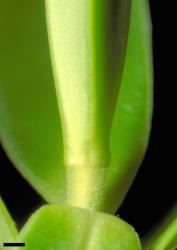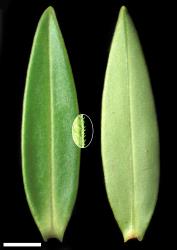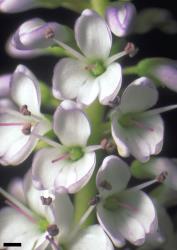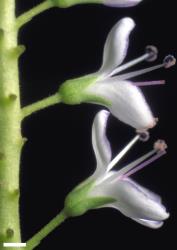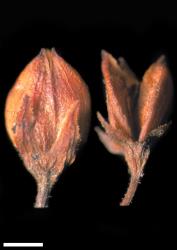- Taxon
- Gallery
- ≡ Hebe barkeri (Cockayne) Cockayne, Trans. New Zealand Inst. 60: 469 (1929)
- = Veronica gigantea Cockayne, Trans. & Proc. New Zealand Inst. 34: 319 (1902)
- ≡ Veronica salicifolia var. gigantea (Cockayne) Cheeseman, Man. New Zealand Fl. 504 (1906)
- ≡ Hebe gigantea (Cockayne) Cockayne in Cockayne & Allan, Trans. New Zealand Inst. 57: 19 (1927)
Small tree to 13 m tall. Stems erect; eglandular-puberulent to -pubescent; hairs uniform. Leaf bud distinct, its outer leaves fully grown, appressed at margins; sinus absent. Leaves opposite-decussate, erecto-patent to spreading; lamina sub-coriaceous, linear-lanceolate to lanceolate, 24–79 mm long, 4–22 mm wide, dull pale green or green above, pale green beneath; midrib evident, secondary veins usually visible in fresh leaves; surfaces with eglandular hairs along midrib and sometimes elsewhere above, sometimes along midrib and rarely elsewhere beneath, and conspicuous to obscure short or sessile glandular hairs, usually in minute pits, especially beneath; margin pubescent, entire; apex acute; base cuneate to abruptly cuneate or sub-cordate; petiole absent. Inflorescence a lateral raceme, 28–76 mm long; flowers crowded, 23–39, all bisexual; bracts alternate to loosely whorled, deltoid or narrowly deltoid to oblong, < pedicels; pedicels erecto-patent to spreading, 1.0–5.5 mm long, eglandular-hairy all around. Calyx lobes 4, acute, 1.5–2.5 mm long, sub-equal, mixed glandular- and eglandular-ciliate, also often pubescent outside. Corolla 6–8 mm diameter; tube white, 1.4–2.0 mm long, < calyx, eglandular-hairy inside; lobes 4, usually white, occasionally pink or bluish, erecto-patent to spreading or recurved, sub-equal to unequal, elliptic, obovate, or rhomboid, 2.5–4.0 mm long, obtuse; nectar guides absent. Stamen filaments white or pale purplish, 4–5 mm long; anthers purple. Style eglandular-hairy, 2.5–4.5 mm long. Capsules latiseptate, sub-acute to obtuse, eglandular-hairy, 4–5 mm long, 2.8–3.3 mm at widest point. Seeds broadly ellipsoid to ellipsoid oblong, flattened, smooth, pale to dark brown, 1.0–1.2 mm long.
The tree habit and hairy leaves are distinctive. V. flavida and V. parviflora also form small trees, but they occur naturally on the New Zealand mainland; V. parviflora leaves are much smaller and narrower, and those of V. flavida are less hairy and have a prominent yellowish patch at the leaf base and the basal part of the midrib.
Among species that also occur on the Chatham Is., V. barkeri can be confused with V. dieffenbachii, but plants of V. dieffenbachii are shrubs, have duller or often greyish-green adult leaves, broadest at or above the middle, leaf margins glabrous although sometimes fringed with a row of long hairs and also occasionally a minute pubescence of short hairs, leaf stomata conspicuous beneath, and corolla tube longer than the calyx and longer than the corolla lobes.
Chatham Is. Known from the southern half of Chatham I. and a single plant on Pitt I. (Rangiauria). An unvouchered record from South East I. (Rangatira) is not represented on the map.
Forest, especially near streams, scrub, coastal scarps. Recorded elevations range from 2 to 244 m.
Flowers: October–December; fruits: December–January.
2n = 40, 80 (the latter all from specimens of cultivated origin) (see Bayly & Kellow 2006, as Hebe barkeri).
Veronica barkeri is classified in V. subg. Pseudoveronica sect. Hebe and the informal group “Occlusae” (Albach & Meudt 2010; Bayly & Kellow 2006).
Juvenile leaves have been described as minutely denticulate, ciliate with long multicellular hairs, pubescent on midrib beneath (Bayly & Kellow 2006).
Hairs inside the ovary locules have been noted in several flowers of V. barkeri and might be a unique and constant characteristic of the species.



